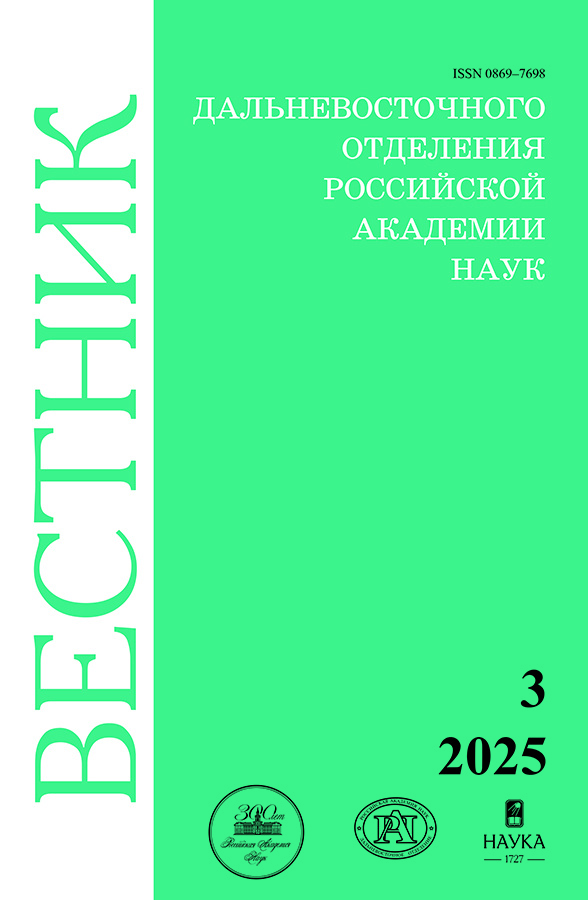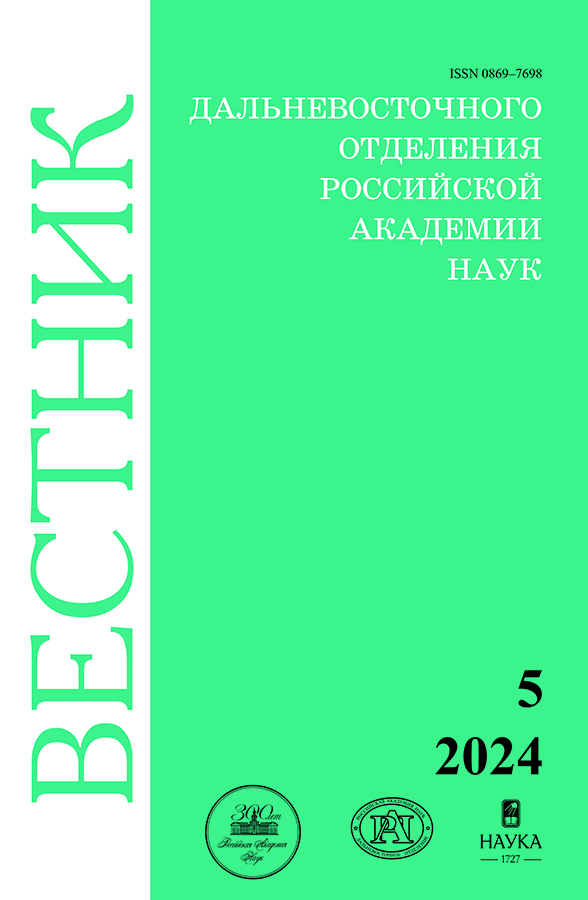Sulfur isotope anomaly in magmatic sulfide mineralization of the Monchegorsk pluton as evidence of subduction processes in the Archean
- Authors: Velivetskaya T.A.1, Ignatiev A.V.1, Vysotskiy S.V.1, Yakovenko V.V.1
-
Affiliations:
- Far East Geological Institute, FEB RAS
- Issue: No 5 (2024)
- Pages: 40-50
- Section: Earth and Environment Sciences
- URL: https://permmedjournal.ru/0869-7698/article/view/685977
- DOI: https://doi.org/10.31857/S0869769824050038
- EDN: https://elibrary.ru/HPXAFA
- ID: 685977
Cite item
Full Text
Abstract
The article presents an interpretation of data for stable isotope composition of sulfur-34 and -33 from sulfide minerals of the Early Paleoproterozoic (~2.5 Ga) Monchegorsk pluton, located in the central part of the Kola Peninsula, Russia. Available data indicate that the sulphide sulfur has both a mantle source and an atmospheric sulfur source with an isotopic anomaly. We believe that atmospheric sulfur (a product of photochemical reactions in the oxygen-free atmosphere of Archean) was transferred from the atmosphere into the deep layers of the mantle due to the processes of subduction of the oceanic crust along with sediments and their subsequent melting. The homogeneous sulfur isotopic composition of sulfur-34 and -33 for sulfide mineralization of the Monchegorsk pluton indicates fairly intense mixing of sulfur from different sources. Thus, the sulfur isotope anomaly archived in the magmatic sulfides of the Monchegorsk pluton provides an opportunity to trace the global circulation of terrestrial matter in the ancient history of the Earth.
Keywords
Full Text
About the authors
Tatyana A. Velivetskaya
Far East Geological Institute, FEB RAS
Author for correspondence.
Email: velivetskaya@mail.ru
ORCID iD: 0000-0002-2833-1026
Candidate of Sciences in Geology and Mineralogy, Leading Researcher
Russian Federation, VladivostokAleksandr V. Ignatiev
Far East Geological Institute, FEB RAS
Email: ignatiev@fegi.ru
ORCID iD: 0000-0002-4452-5496
Candidate of Sciences in Geology and Mineralogy, Leading Researcher
Russian Federation, VladivostokSergey V. Vysotskiy
Far East Geological Institute, FEB RAS
Email: vysotskiy@fegi.ru
ORCID iD: 0000-0002-5194-5616
Doctor of Sciences in Geology and Mineralogy, Chief Researcher
Russian Federation, VladivostokViktoriya V. Yakovenko
Far East Geological Institute, FEB RAS
Email: yakovenko_v.v@mail.ru
ORCID iD: 0000-0003-3834-3626
Candidate of Sciences in Geology and Mineralogy, Senior Researcher
Russian Federation, VladivostokReferences
- Seal R. R. Sulfur isotope geochemistry of sulfide minerals. Reviews in Mineralogy and Geochemistry. 2006;(61):633–677. doi: 10.2138/rmg.2006.61.12.
- Johnston D. T. Multiple sulfur isotopes and the evolution of Earth’s surface sulfur cycle. Earth-Science Reviews. 2011;(106):161–183. doi: 10.1016/j.earscirev.2011.02.003.
- Montinaro A., Strauss H., Mason P. R.D., Roerdink D., Münker C., Schwarz-Schampera U., Arndt N. T., Farquhar J., Beukes N. J., Gutzmer J., Peters M. Paleoarchean sulfur cycling: Multiple sulfur isotope constraints from the Barberton Greenstone Belt, South Africa. Precambrian Research. 2015;(267):311–322. doi: 10.1016/j.precamres.2015.06.008.
- Farquhar J., Wing B. A., McKeegan K.D., Harris J. W., Cartigny P., Thiemens M. H. Mass-independent sulfur of inclusions in diamond and sulfur recycling on early Earth. Science. 2002;(298):2369–2372. doi: 10.1126/science.1078617.
- Bekker A., Grokhovskaya T. L., Hiebert R., Sharkov E. V., Bui T. H., Stadnek K. R., Chashchin V. V., Wing B. A. Multiple sulfur isotope and mineralogical constraints on the genesis of Ni-Cu-PGE magmatic sulfide mineralization of the Monchegorsk Igneous Complex, Kola Peninsula, Russia. Mineralium Deposita. 2016;(51):1035–1053. doi: 10.1007/s00126-015-0604-1.
- Ono S. Photochemistry of sulfur dioxide and the origin of mass-independent isotope fractionation in earth’s atmosphere. Annual Review of Earth and Planetary Sciences. 2017;(45):301–329. doi: 10.1146/annurev-earth-060115-012324.
- Veliveckaya T. A., Ignat’ev A.V., Yakovenko V. V. Mass-nezavisimoe frakcionirovanie izotopov sery v fotokhimicheskikh processakh SO2 pod vozdejstviem UF izlucheniya razlichnykh dlin voln. Geokhimiya. 2020;(65):1080–1091. (In Russ.). doi: 10.31857/S0016752520110102.
- Vysockij S. V., Veliveckaya T. A., Ignat’ev A.V., Aseeva A. V., Yakovenko V. V. Vliyanie arkhejskoj atmosfery na formirovanie vulkanogenno-osadochnykh sul’fidnykh rud (po dannym mul’tiizotopnogo sostava sery). Vestnik of the FEB RAS. 2023;(4):70–81. (In Russ.). doi: 10.37102/0869-7698_2023_230_04_5.
- Sharkov E. V., Chistyakov A. V. Geologo-petrologicheskie aspekty EHPG-Cu-Ni-orudeneniya v rannepaleoproterozojskom Monchegorskom rassloennom mafit-ul’tra-mafitovom komplekse (Kol’skij poluostrov). Geologiya Rudnykh Mestorozhdenij. 2014;(56):171–194. (In Russ.). doi: 10.7868/S0016777014030046.
- Grohovskaya T. L., Ivanchenko V. N., Karimova O. V. Griboedova I. G., Samoshnikova L. A. Geologicheskoe stroenie, mineralogiya i genezis EHPG mineralizacii massiva Yuzhnaya Sopcha, Monchegorskij kompleks, Rossiya. Geologiya Rudnykh Mestorozhdenij. 2012;(54):416–440. (In Russ.). doi: 10.1134/S1075701512050029.
- Chashchin V. V., Bayanova T. B., Mitrofanov F. P., Serov P. A. Malosul’fidnye platinometal’nye rudy paleoproterozojskogo Monchegorskogo plutona i ego yuzhnogo obramleniya (Kol’skij poluostrov, Rossiya): geologicheskaya kharakteristika i izotopno-geokhronologicheskie svidetel’stva polikhronnosti rudno-magmaticheskikh sistem. Geologiya Rudnykh Mestorozhdenij. 2016;(58):41–63. (In Russ.). doi: 10.7868/S0016777016010020.
- Vysockij S. V., Orsoev D. A., Ignat’ev A.V., Veliveckaya T. A., Aseeva A. V. Istochnik sery dlya Ni-Cu sul’fidnoj mineralizacii Monchegorskogo intruzivnogo kompleksa (Kol’skij poluostrov, Rossiya) po mul’tiizotopnym dannym. In: Ul’tramafit-mafitovye kompleksy: geologiya, stroenie, rudnyj potencial: Materialy V Mezhdunarodnoj konferencii. Ulan-Udeh: Izdatel’stvo Buryatskogo Gosudarstvennogo Universiteta; 2017. P. 83–86. (In Russ.).
- Grinenko L. N., Grinenko V. A., Lyakhnickaya I. V. Izotopnyj sostav sery sul’fidov medno-nikelevykh mestorozhdenij Kol’skogo poluostrova. Geologiya Rudnykh Mestorozhdenij. 1967;(9):3–17. (In Russ.).
- Labidi J., Cartigny P., Hamelin C., Moreira M., Dosso L. Sulfur isotope budget (32S, 33S, 34S and 36S) in Pacific–Antarctic ridge basalts: A record of mantle source heterogeneity and hydrothermal sulfide assimilation. Geochimica et Cosmochimica Acta. 2014;(133):47–67. https://doi.org/10.1016/j.gca.2014.02.023
- Sobolev A. V., Asafov E. V., Gurenko A. A. et al. Deep hydrous mantle reservoir provides evidence for crustal recycling before 3.3 billion years ago. Nature. 2019;(571):555–559. https://doi.org/10.1038/s41586-019-1399-5
Supplementary files









